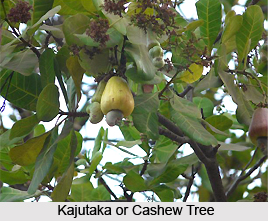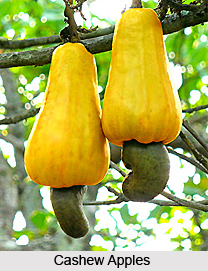Kajutaka is commonly known as `kaju` in most part of India though cities call it in different names for instance `mundhiri kottai` in Tamil Nadu. Whatever the name goes Kajutaka is famous as an Indian medicinal plant since ages.
 Kajutaka is a small, spreading evergreen tree though it sometimes reaches to the height of 12 metre. The leaves of the plant are obovate or obovate-oblong, coriaceous, glabrous, apex obtuse-retuse or rounded and base cuneate. They are 6 centimetres to 15 centimetres long and 5 centimetres to 8 centimetres wide, somewhat crowded at the ends of twigs. Flowers are small and coloured with yellow and pink stripes. The flowers are blossomed in 15 centimetres to 25 centimetres long terminal panicles, with both staminate and hermaphrodite flowers. The fruit of kajutaka is shaped like a kidney and this is basically a nut.
Kajutaka is a small, spreading evergreen tree though it sometimes reaches to the height of 12 metre. The leaves of the plant are obovate or obovate-oblong, coriaceous, glabrous, apex obtuse-retuse or rounded and base cuneate. They are 6 centimetres to 15 centimetres long and 5 centimetres to 8 centimetres wide, somewhat crowded at the ends of twigs. Flowers are small and coloured with yellow and pink stripes. The flowers are blossomed in 15 centimetres to 25 centimetres long terminal panicles, with both staminate and hermaphrodite flowers. The fruit of kajutaka is shaped like a kidney and this is basically a nut.
The fruits of kajutaka are 2.5 centimetres long and borne on a 5 centimetres to 7.5 centimetres long, fleshy receptacle. The cashew apple has a thin, bright yellow to scarlet skin and soft, juicy flesh. The nut is greyish-green in colour with a hard, smooth and shining sebaceous seed vessel enclosing a curved, white kernel covered with a thin, reddish-brown seed coat. The fruits of kajutaka known as `kaju badam` is a nut in the culinary sense, but in the botanical sense the fruit of the cashew is a seed. A double shell containing a dermatogenic phenolic resin, urushiol, a potent skin irritant toxin also found in the related poison ivy, surrounds the seeds.
In the 16th century the Portuguese introduced Kajutaka to India and since then there was no looking back. Now it is cultivated as a major export crop in around thirty two countries of the world like Maharashtra, Goa, Karnataka, Kerala, Tamilnadu, Andhra Pradesh, Orissa and West Bengal, with its cultivation concentrated in the coastal areas of the country and almost in all regions with a sufficiently warm and humid climate. In many areas it has become naturalized.

The fruit of Kajutaka, Indian medicinal plant is delicious as well as nutritious. The cashew kernel is eaten as a dessert and is an important item of confectionery. It is generally used raw, but sometimes are roasted or fried and salted. The juicy, pleasantly aromatic, cashew apple has a sweet, slightly astringent taste when ripe, and is eaten raw. Cashew nuts or `kaju` is fermented to make wine or brandy, or is used for making juice, syrup, confectionery and pickle after removing the astringent principle. The Patamona of Guyana uses many parts of the plant medicinally. The cashew apple as well as the juice possesses antidiarrhoeal and antiscorbutic properties. The cashew nutshell liquid is a by-product of processing cashew. This juice is mostly composed of anacardic acids. The fermented juice of cashew nut is valued as a diuretic and is useful for relieving kidney troubles and advanced cases of cholera. The resinous juice contained in the seeds is used to treat cases of mental derangement, sexual infirmity, morning sickness, heart palpitations, rheumatic pericarditis, and loss of memory following recovery from smallpox.
The kernel of the fruits of Kajutaka, Indian medicinal plant is also considered as good food for weak patients suffering and those who are from incessant and chronic vomiting. Oil extracted from the cashew nut shell is used as a mosquito larvicide, is a mild purgative. It is also used in the treatment of hookworm and for the treatment of cracks on soles of feet, warts, corns and leprous sores. The bark is alterative and astringent; bark extracts reportedly possess anti-hypertensive properties and can lower blood sugar when taken orally. The bark is skinned and soaked overnight or boiled as an antidiarrhoeal drug. Tar that is obtained from the bark is applied externally to treat leprosy, corns, ulcers, as a counter-irritant, medicinal drug and vesicant. The root of the cashew nut possesses purgative properties.











